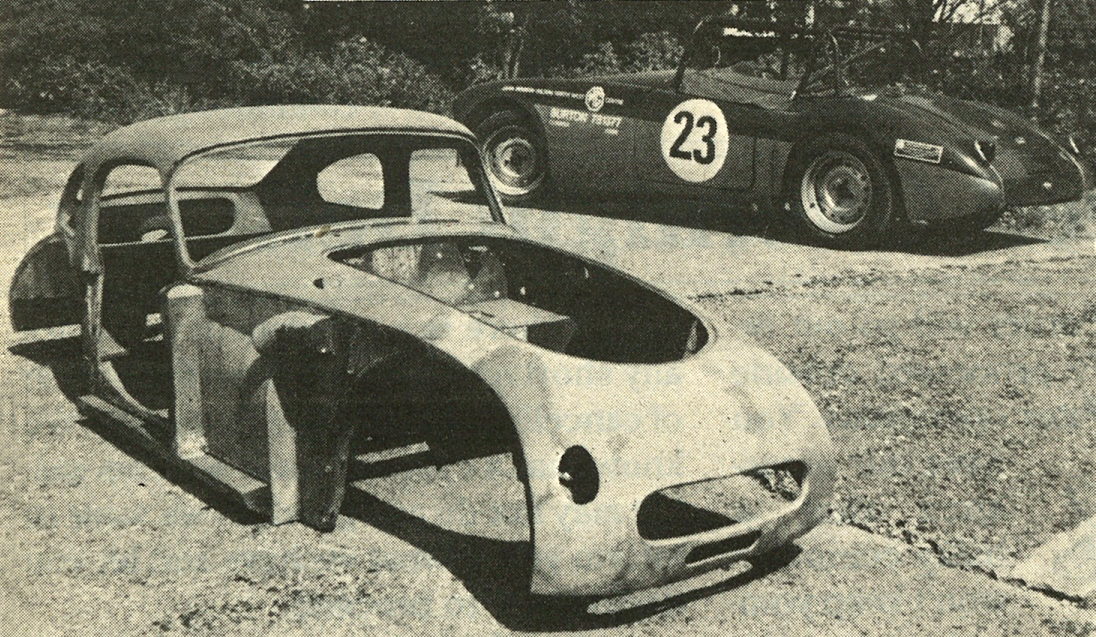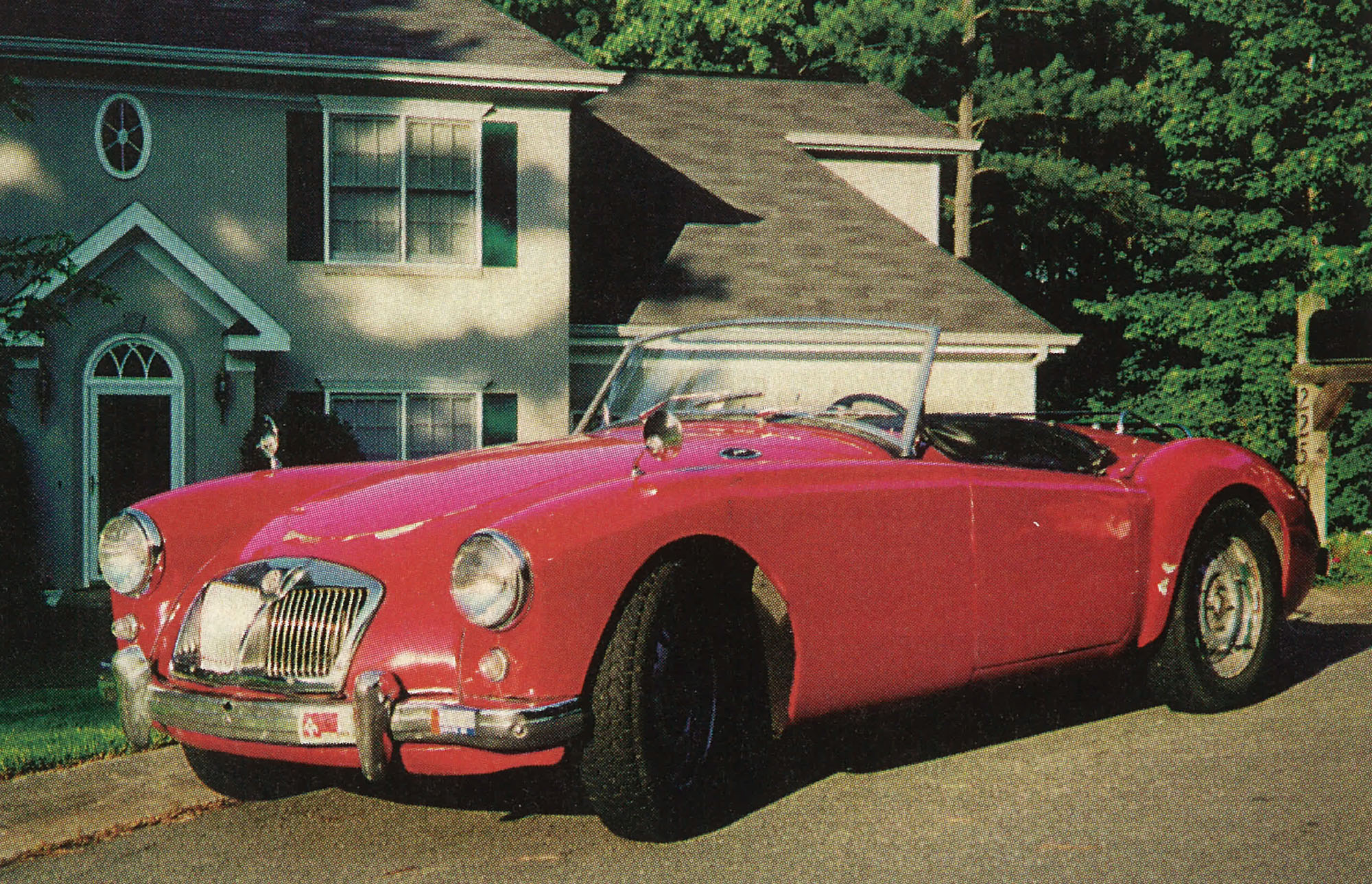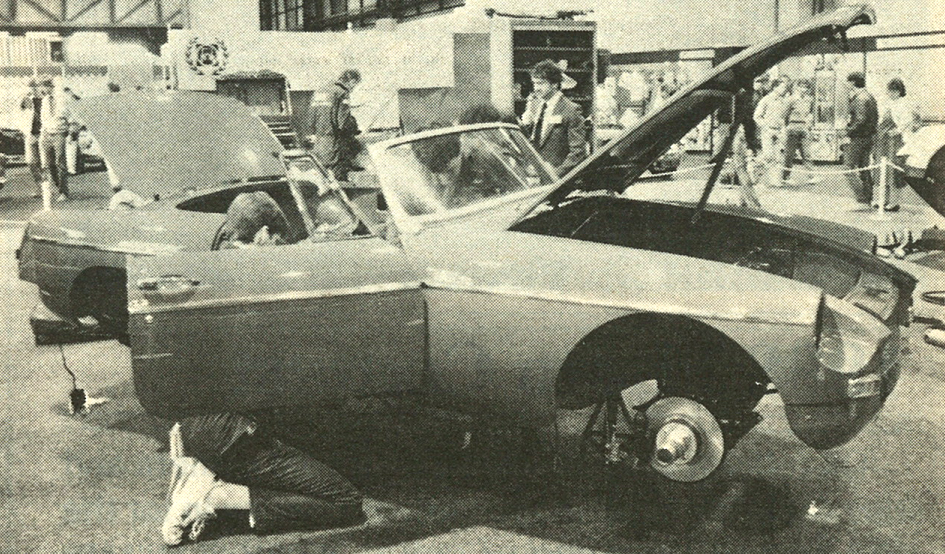Moss Motoring Fall 1988
One of the advantages of being “in the business” is the occasional bit of information which floats my way. While I was in England, our manager at Moss Spares commented that he knew the whereabouts of SRX 210 and asked if I would be interested in taking a look. I’m not a great student of license plate history, but I know the British penchant for famous or unusual automobile registration numbers, and I also know that SRX 210 is the Ted Lund Le Mans MGA Twin Cam. My answer was an unqualified yes.
 In stark contrast to the pushrod MGA’s introduction in prototype form at Le Mans in 1955, the Twin Cam never enjoyed full official factory support at the classic French race. A special Twin Cam road race car was built under the factory code name EX186, but was never used in competition. The car hung around the factory for a few years, then was suddenly packed up and shipped to the U.S. EX186 still exists and is currently being restored to its original condition, but to my knowledge it has never participated in a major race.
In stark contrast to the pushrod MGA’s introduction in prototype form at Le Mans in 1955, the Twin Cam never enjoyed full official factory support at the classic French race. A special Twin Cam road race car was built under the factory code name EX186, but was never used in competition. The car hung around the factory for a few years, then was suddenly packed up and shipped to the U.S. EX186 still exists and is currently being restored to its original condition, but to my knowledge it has never participated in a major race.
 No factory sponsored MGAs raced in the 1956-58 period, and it was only through the efforts of the MG Car Club’s Northwest Centre that the type returned in 1959. Members of the Northwest Centre, keen to see an MGA back at Le Mans, contacted John Thornley and convinced him to support an effort. The Twin Cam roadster Abingdon prepared for the event was not significantly removed from the standard road going car of that period. The engine was specially prepared but produced little more power than a standard engine. An under-shield was fitted, a long range fuel tank was installed and other necessary modifications were made for the grueling race.
No factory sponsored MGAs raced in the 1956-58 period, and it was only through the efforts of the MG Car Club’s Northwest Centre that the type returned in 1959. Members of the Northwest Centre, keen to see an MGA back at Le Mans, contacted John Thornley and convinced him to support an effort. The Twin Cam roadster Abingdon prepared for the event was not significantly removed from the standard road going car of that period. The engine was specially prepared but produced little more power than a standard engine. An under-shield was fitted, a long range fuel tank was installed and other necessary modifications were made for the grueling race.
The 1959 Le Mans team consisted of the one MGA, a dozen car club volunteers, mechanic Henry Stone who took a vacation from his job in MG’s experimental shop to participate and the drivers Ted Lund and Colin Escott, both of whom had raced MGs previously. Despite the amateur nature of the team, they ran extremely well up until the eighteenth hour when Colin Escott struck a large dog on the Mulsanne straight. Damage resulting from the impact caused a restriction of airflow to the engine and gearbox which ultimately led to overheating and a seized gearbox. What started as a promising performance, ended as a disappointing failure.
The team decided to run again in 1960, so once more the car was prepared. This time, the body was rebuilt into a fastback coupe under the direction of Don Hayter from the Abingdon Design Office. The body was hurriedly constructed at Bodies Branch and employed pop rivets to hold all the panels together. Despite this questionable construction technique, the car’s exterior is beautifully smooth in the best Abingdon tradition. The engine was bored out to 1762cc and other work was done to ensure reliability, but once again the car’s basic mechanical specification bore a strong resemblance to a standard car. Things went well in 1960, the Twin Cam finished first in class and 13th overall. Among the cars beaten by the MG were a team of three experimental Triumph Twin Cams which despite a 200cc displacement advantage, couldn’t keep up with the MG.
The MGA Twin Cam went out of production in 1960, but the Northwest Centre team returned to Le Mans for one last try in 1961. To improve streamlining and provide more downforce, a special nose was built for the car. The traditional MG grille was discarded and the headlight locations moved back along the fenders. With the promise of another good performance ahead the Twin Cam started the ’61 race and within two hours came to rest, the victim of a broken rod bolt.
SRX 210 never ran again at Le Mans, instead it “retired” to the club circuits of England where it put up creditable performances until its overall weight (the car was built for reliability, not pure speed) made it uncompetitive against the current crop of super-lightweight roadsters. Although some accounts tell that no effort was spared to lighten the car, this is not true. Certain components of the rolling chassis have been drilled until there is little left, but the basic frame and its superstructure were never touched. Considering how overbuilt the MGA frame has proven, I think they could well have taken a great deal of weight out of the frame without ill effects. The coupe body and extra racing equipment more than made up for any weight saved by drilling the floorboard mounting rails.
As is the case with so many cars, SRX 210 is currently undergoing restoration on about the ten-year plan. I visited the Northwest MG Centre in Holme where the car is located. The proprietor, John Benson-Wilson proved to be an extremely friendly host and even pulled the body and chassis out of the alcove in which they were stored so I could take pictures. Unfortunately, the engine and interior components were not available for viewing, so I guess I’ll just have to go back for another look. John said the car’s owner was spending about ten pounds at a time on the car and that it would take some time to finish.
SRX 210 exhibits many of the characteristics which make English cars so endearing to Americans. As mentioned previously, the body is held together with pop rivets. John showed off some new pieces which he had installed on the body. When was the last time you used a hand riveter to make proper “original” repairs? In defense of the body-shell, I must say that it appeared to be beautifully smooth. Obviously, much care had been taken in forming the panels. John also pointed out a rather nasty looking heli-arc weld running across either side of the front apron. He wasn’t sure of its origins, but it may be that when the nose was changed for the 1961 event the work was done with less than the normal MG care.
Other visible differences from a standard Twin Cam include adjustable rear lever arm shocks, a dual fuel pump mount (neatly installed and drilled for lightness), quick lift jacking points at the ends of the frame and a factory optional anti-sway bar. Because the car is stripped down, many potentially interesting bits and pieces were not available for viewing. We’ll check back in down the road to see how things are going.
After spending time on the car itself, John took me around his parts, service and restoration facilities for a look. The shop itself is a stone building which at one time was part of a dairy operation — how typically English. After spending time in the shop we wandered out to have a look at his latest MGA race car, but that’s a story for a future issue of Moss Motoring.
By Robert Goldman







'SRX210: The Le Mans MGA Twin Cam' has no comments
Be the first to comment this post!